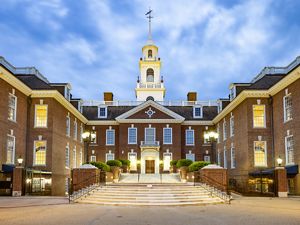
Delaware Conservation Blueprint
A Map Analysis of Open Space, Sea Level Rise and Wildlife Habitats
Delaware’s natural lands are under increasing pressure from development and sea level rise (SLR). By 2050, 46% of protected lands in Delaware are projected to be impacted by SLR. Known for its stunning beaches and marshes, Delaware must ensure these vital ecosystems have adequate migration space to adapt to coastal inundation and subsidence. To address this challenge, the state needs a cohesive conservation vision to safeguard its natural resources.
On behalf of the Delaware Land Protection Coalition, The Nature Conservancy has developed a statewide conservation blueprint that identifies Conservation Opportunity Areas (COAs) to protect critical wildlife habitats with a focus on those at risk from SLR. This analysis prioritizes Delaware’s key habitat types, including beaches, dunes, coastal forests, tidal and freshwater marshes, small rivers, and associated forested floodplains and wetlands. It considers factors such as habitat size, connectivity, proximity to protected areas and potential marsh transition zones.
The Delaware Conservation Blueprint provides a comprehensive framework to guide the conservation of the state’s unique ecosystems.
Methodology
The Nature Conservancy used existing datasets to produce the Delaware Conservation Blueprint, including habitat types from the Northeast Habitat Classification, coastal inundation projections, 1-meter land cover, the DE Ecological Network, and protected lands.
Conservation Opportunity Areas (COAs) focus on rare target habitats (maritime forest, beach, dune, peat swamp) of any size and other target habitats (salt marsh; swamp; hardwood forest; tidal creeks and headwaters; tidal small and medium rivers; warm, low-gradient headwaters and creeks) in patches greater than 100 acres that are adjacent to protected lands and within DE Ecological Network corridors and cores. COAs also include potential marsh/ecosystem transition zones that are in natural cover and between 5ft and 7ft sea-level rise projections.
Want More Information?
For more information about the Delaware Conservation Blueprint, contact Emily Knearl, Delaware Director of Government Relations & External Affairs.
Delaware Land Protection Coalition (DLCP)
The DLPC is a group of conservation-focused organizations committed to increasing the amount of Delaware lands—including natural, cultural, historical, and recreational resources—protected through acquisition or conservation easement. DLPC members include: Delaware Center for Inland Bays, Brandywine Red Clay Alliance, Delaware Wild Lands, The Nature Conservancy, Kent County Conservancy, Ducks Unlimited, Delaware Ornithological Society, Delaware Nature Society, Sierra Club, Sussex County Land Trust, Land Trust Alliance, Preservation Delaware, Nanticoke River Watershed Conservancy, League of Women Voters, Mt. Cuba, and representatives from New Castle County and Kent County.
Download

We Can’t Save Nature Without You
Sign up to receive monthly e-mails about conservation news & opportunities in DE
















